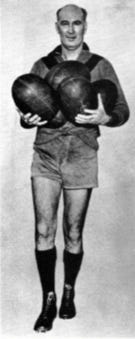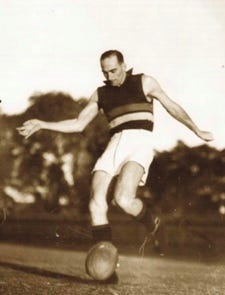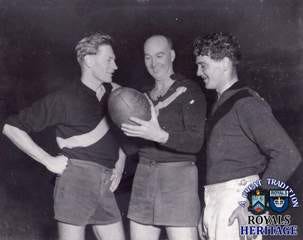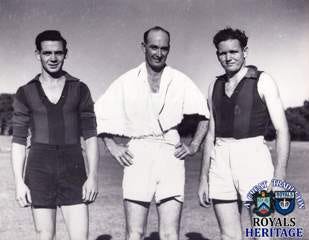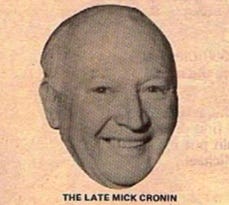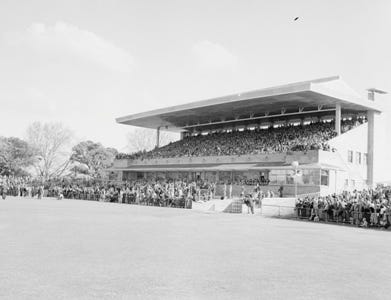Mick Cronin - A 50 year legacy in football.
Above Figure 1. Mick Cronin. Source: australianfootball.com
A 50-year legacy in football
By Rick Vredenbregt
Lost WAFL
Deverick John 'Mick' Cronin is a legendary name and figure in Western Australian football history. This is due to a legacy encompassing nearly 50 years as a player, umpire, coach, and media critic. Tragically, he passed away suddenly from a ruptured aortic aneurysm that ended his life aged just 68 on the evening of September 1st, 1979. Only a few hours prior, Cronin had been providing special comments alongside fellow Channel Seven commentators Keith Slater and Bob Miller, during a thrilling WAFL 1st semi-final at Subiaco Oval, between his beloved East Perth and eventual premiers East Fremantle. The Royals went down by just 2-points; however, Cronin's death was the saddest event for the East Perth faithful that day. This sadness, and shock, extended throughout the Western Australian football community at large, due to the high esteem Cronin was held by players, coaches, umpires, administrators, and supporters alike.
Two days following Cronin's death, the Daily News said(1):
"As a critic, he built a reputation as an honest, straight from the shoulder commentator who never side stepped an issue in which he firmly believed. But there was also another Mick Cronin. This was the helper, the teacher who spent countless hours helping kids and league players strengthen their game."
Cronin has the distinction Australia wide of being one of the few, if not the only man, to have played league football, umpired league football, coached league football and critiqued league football whilst working in the media.
As a player, Cronin was recruited to East Perth as a 19-year-old in 1930 having grown up in Wagin, going to school in Toodjay and working as a delivery boy and apprentice butcher in Harvey. The Royals found Cronin some work in Perth, initially for a grocer and later at Whitty's lottery agency and Boans department store.
A talented left foot centreman/half-forward (see fig. 2)., Cronin played 164 league games with East Perth between 1930 and 1940, winning the Fairest and Best award in 1931, captaining the side between 1936 and 1940, including the 1936 premiership victory and representing Western Australia on 12 occasions. Perhaps his crowning moment as a player was achieved during the 1937 Australian State Football Carnival in Perth, winning the inaugural Tassie Medal as the Fairest and Best player across all states at the highest level. Cronin is one of three Royals to win the 'Tassie', along with Graham Farmer in 1956 and Ken McAullay in 1972.(2)
Above Figure 2. Mick Cronin. Source: Wikipedia
On Cronin's Tassie Medal, the 'Fight On East Perth'website said(3):
"The East Perth captain was arguably at the peak of his form during this interstate football carnival in Perth when he put in two near best – on – ground performances in helping Western Australia to annihilate South Australia by 19 goals and get to within 8-points of an all-powerful VFL side."[sic]
Recalling Cronin’s football attributes was Bert Boundy, who played 13 games with him between 1934 and 1936. Aged 92 at the time, Boundy recounted at the East Perth football clubs (EPFC) 100-year reunion in 2006(4):
"A brilliant drop kick and a most astute football thinker who led the team when Jerry Dolan was coaching on the sidelines."
This was in reference to the 1936 premiership when Cronin was captain and the legendary Dolan was coach.
Jim Washbourne, a veteran of 156 league games from 1944 to 1957 and a member of the East Perth team of the century (1945-2006 period), had this to say about Cronin in the clubs history book titled 'The Royals - 100 Years of tradition; A history of the East Perth Football Club' that was launched in 2006 at the centenary celebrations-reunion for all former past players and officials(5):
"Mick Cronin was a terrific guy, very dedicated and he helped mould the team for Jack Sheedy's arrival. But Mick was possibly too nice a guy and we probably couldn't carry out what he wanted us to do."
Cronin was named on a half-forward flank in East Perth's 1906-1944 team of the century and both teams from the two era's 1906-44 and 1945-2006, were unveiled at the club’s centenary celebrations.
Along with many champions of that era, Cronin joined the armed forces, serving four years in the army between 1942 and 1946. It was in 1946 where Cronin began his coaching career, taking charge of the East Perth colts for one season before turning his hand to umpiring. He officiated in 26 league games and was selected to umpire at the 1947 Australian football carnival in Hobart. Following a couple of years in white, Cronin ventured back into coaching, firstly with the South Perth juniors, before being given the job of coaching his beloved East Perth in league football.
As Washbourne mentioned earlier, many credit Cronin's coaching as being pivotal to the successful reign, between 1955 and 1964, that followed for his successor Jack Sheedy. Cronin, a pioneering exponent of the run-on game, blooded many of the future stars that went on to greater heights, in much the same way as Ray Richards did at Claremont a decade later, when he brought new blood to the Tigers that would go on to be household names, such as Dennis Marshall, Wayne Harvey and Lorne Cook et al.
In his Graham 'Polly' Farmer biography, Steve Hawke wrote of "The Cronin Years"(6):
"His arrival had been a steadying influence after a turbulent period had seen five coaches at the helm in three seasons. Cronin was a favourite son of the club, and a man whose life revolved around football."
Above Figure 3. Mick Cronin. Source: Royals Museum on X (Twitter).
Cronin was a kind of 'Mr Fix it' in a transitional period for East Perth and had a policy of blooding new talent. There were no less than 16 new players that would make their debut during his second stint as league coach (see fig. 3). He had future great names such as Graham Farmer, Ted Kilmurray, John K. Watts, Paul Seal, Kevin McGill, Tom Everett and Geoff Burton under his tutor ledge, just as they were beginning their league careers.
Above Figure 4. Mick Cronin. Source: Royals Museum on X (Twitter).
Sheedy, also alluded to the fact that Cronin was perhaps the early architect of the successful teams that he later coached, when telling Keith Slater in 1998 about his arrival at Perth Oval during Slaters ‘Football Legends’ television interview series for the Seven Network(7):
Keith Slater: "East Perth hadn't won a premiership since the underage competition in 1937.
Jack Sheedy: "No they hadn't, and Mick Cronin had been coach and probably had a group of good young fellows coming on the previous couple of years.
However, as Jim Washbourne alluded to with his “possibly too nice a guy” comment, perhaps Cronin didn't have the legendary ruthless edge that Sheedy possessed.
Cronin may have gone a season earlier if not for a sharp turn of events after an initial resignation as coach in December 1954. Following this, he was then elected vice-president of East Perth, only having to rescind his new position quickly and return yet again as league coach at the eleventh hour for the 1955 season. This was due to the fact ex-West Perth and South Melbourne ruckman defender Don Scott, almost signed, sealed, and delivered as the Royals new playing coach, was poached back again to cross town arch rivals the Cardinals.
On Cronin's eventual resignation the following year and Jack Sheedy's appointment to replace him, a club statement to members said(8):
"Due to the intention of Mr D.J. (Mick) Cronin signifying that he would not carry on as your coach, the club was fortunate in obtaining the services of that very colourful footballer, former East Fremantle person, Mr Jack Sheedy."
Legendary East Perth stalwart player, assistant coach and selector over 65 years, Jack Clayton, also remembered Cronin during a turbulent period for the club in 'The Royals - 100 Years of tradition A history of the East Perth Football Club’ (9):
"He was my first coach in 1941(see fig. 4). and was just a great guy, but he moved aside for the arrival of Jack Sheedy. He accepted it ok, as he had been there for a while, and he acknowledged that the team wasn't really getting anywhere. Apart from being a very clever and talented centreman, he did have a great football brain, which showed out over many years as a media critic."
Tributes flowed thick and fast in the hours and days following Cronin's sudden passing. Channel Seven's 'World of Football' panel, of which Cronin was a weekly member, were understandably shocked that their esteemed friend and colleague was no longer alongside them and six days later, Gary Carvolth acknowledged the sombre occasion in the Westside Football(10):
"One of the toughest assignments the World of Football panel has experienced. Mick of course was close to us all, but he had a particular affinity with Frank Sparrow. Frank, I know, won everybody's admiration for the way he handled the opening of an emotion-charged programme."
Without wanting to sound macabre, it was perhaps fitting that Cronin departed this world on the same day that he added special comments to Channel 7's coverage of the First Semi-Final between East Fremantle and his beloved East Perth. Cronin would also have been extremely proud that two East Perth products, Mal Brown and Bradley Smith, were in charge of the 1979 Grand Final teams, South Fremantle and East Fremantle respectively. Cronin provided guidance and assistance to Brown and Smith during their formative days at the Royals.
A Westside Football tribute said(11):
"As a critic, Mr Cronin was often outspoken; often controversial. But there are few people who are better qualified than him to comment on the game that he loved so much. Sincerity and honesty was the Cronin gospel. He saw the game through unbiased eyes, and he never spoke with a forked tongue. What he said was genuine and from the heart."
Each year, in perpetual honour of Cronin's legacy, the WA Football Media Guild present a TV award named after him: 'The Mick Cronin Best News Feature Story', such was his impact over several decades providing opinion and comment on football in this state. Doyen of Western Australian football journalism, the great Geoff Christian, was lavish in praise of Cronin when he wrote in The West Australian two days after his death(12):
"D. J. (Mick) Cronin established an enviable reputation as a player, coach, umpire and television commentator in his 50-year association with league football. There was no-one better qualified to talk about the game he loved and a game that helped make him one of the best-known names in WA. There was a sense of history surrounding Mick Cronin."
Above Figure 5. Mick Cronin. Source: Westside Football
As an umpire, Cronin officiated in 26 league games, including a winning streak breaking game in 1947 when South Fremantle defeated archrival East Fremantle, who had registered 35 consecutive wins up to that stage. He also controlled the 1947 Grand Final between South Fremantle and West Perth when the Southerners broke a 30-year premiership drought, and the 1947 Australian Carnival held in Hobart. So well regarded as an umpire, Cronin drew praise from the legendary Jack Sheedy, for his ability with the whistle in Sheedy's 1969 book 'My Football Life' (13).
"Some umpires have perfect understanding with the players. I had a good on-field association with Mick Cronin, Len Gardner, and Frank 'Smokey' Woods, to name just a few. Mick didn't give the right decision all the time. What umpire could? But he had been an outstanding player himself, a Tassie medal winner in fact, and he had perfect appreciation of other players thinking, he explained his rulings clearly and could handle most people including me. Cronin and these chaps had a knack of putting you in your place. You could make a remark such as 'Turn it up Mick' or 'Give us a go'. Mick would just laugh or say something that would make you feel pretty small."
Cronin was always honest and balanced in his views on football, putting loyalties aside, whether towards his club, or the umpires, whenever he critiqued the game. This ‘balance' was encapsulated during a 1966 controversy when he accused the WA umpires board of censuring league umpire Lindsay Johnston. It related to Johnston's officiating of a game between West Perth and East Fremantle at Leederville Oval on April 30th. Despite standing by his criticisms, Cronin issued an apology that was enacted following the boards refuting of his accusations. In his weekly Sports Review column on Friday June 10th 1966 headlined, "Cronin Say's Sorry", he wrote(14):
"My apologies are extended to the WA umpires board. I was mistaken in my article (May 20) when I accused them of having censured umpire Lindsay Johnston. However, Johnston WAS taken to task by at least one prominent umpiring official and the criticism WAS in relation to the West Perth v East Fremantle match at Leederville Oval on April 30th, as I wrote originally. In fairness to the umpires board and its members I also realise now that at the time my article appeared – if not now – at least some board members were probably not aware that Johnston had come under fire from an official level."
Displaying his fairness and balance in observation and critique, Cronin stood by Johnston, whilst also intimating that umpires shouldn't be a protected species from criticism:
"At the time I felt strongly, and I still do, that the complaints about Johnston's handling of the Leederville Oval match were not unwarranted (He was said to be too slow and not clear enough with his decisions). My indignation was prompted by a keen desire to see this young man of quite outstanding ability given every opportunity to develop. At the same time, it is fully appreciated that no umpire should be free from constructive criticism aimed at improvement."
Johnston, like Cronin, was one of the many ex-players who went from playing into umpiring. He played 27 league games with Swan Districts between 1959 and 1962, including their famous first premiership in 1961 against East Perth, where his three goals in 10 minutes during the final term broke the Royals spirit.(15) Following his playing career, Johnston went on to umpire 91 league games between 1965 and 1972 over two stints, including the 1971 grand final between West Perth and East Perth. At the time of Cronin's June 1966 article, Johnston was only one year into his umpiring career, and looking back, Cronin was succinct and prophetic in the potential he saw in him.
"He gave one of the finest exhibitions of umpiring I have seen in this state for many years...he came as close to perfection as possible to get, under present - day conditions."
Cronin pushed Johnston's credentials forward to be the WA umpire at the Australian football championships at Hobart later in June 66'. This never eventuated; however, Johnston did get the opportunity to umpire at the 1972 carnival held in Perth. Four decades later, Johnston acknowledged Cronin's influence telling the late Ron Head:
"I received great support from ex-player, umpire and coach, Mick Cronin, who would call into the shop on his way to the races during the week to discuss the games with me."
Johnston had worked in the menswear department of Freecorns store in Midland, and like Cronin, would later also venture into the media in a brief stint on a Channel Nine football show alongside great names such as Neil Garland, Ray Sorrell, and Charlie Skehan.
An inaugural inductee into the EPFC Hall of Fame in 2006, Cronin was also a pivotal figure in the construction of the grandstand at Perth Oval (now HBF Park) 50 years earlier.(16) Later to be named after East Perth's legendary president Fred Book (see fig. 6), the concrete grandstand had its origins when it was put into central focus by Cronin, "Knocker" Bruce and 1929 Sandover Medallist Billy Thomas. Several years earlier, the trio initially had alerted the Perth City Council (PCC) regarding the issue of the old wooden grandstand and its need for "urgent repair".From here, a 'General Purpose Committee' chaired by Book, was charged with investigating the possibility of building a new structure and lobbying the PCC for financial support. During this period, Book had also been elected as councillor representing the PCC East Ward in 1944, where he fought "vigorously" for his club’s proposal, off the back of Cronin and co's initial concerns. The PCC eventually agreed to provide a loan assisting the £100,000 development, and the rest is history, with the new structure that still stands today officially opening on June 9th, 1956 (see fig. 7).
Above Figure 6. Fred Book. Source: "The Royals - 100 Years of tradition A history of the East Perth Football Club" Alan East.
Above Figure 7. Perth Oval grandstand opening day June 9th, 1956. Source: Sean Cowan.
In his booklet, The Royals 1906 - 1976, celebrating the East Perth football clubs 70th anniversary, Mathew Glossop wrote an anecdote, embellished with humour, whilst Cronin was coach of the Royals.(17) It revealed that an 'accident' by the larger-than-life John. K. Watts had led to Cronin losing almost all his hair. The story goes that 'Wattsey', at that stage just on the brink of league selection, had been advised by Cronin at training one night to finish up early and hit the showers. 'Wattsey', struggling to light the gas burner that provided hot water for the showers, gave up and decided to "turn off the pilot lamp" in a bid to save gas before heading off home, because the league side were still training. However, he didn't think to turn the gas off as well! Later, once training had finished, Cronin hopped in the shower and hopped straight out again due to it being stone cold; "BLOODY HELL!" yelled Mick, "Some dill has turned off the gas, this water is freezing cold!" Cronin went to get some matches to light the burner, however, unbeknown to him the gas had been "building up for the last half hour". Well, you can guess what happened next, as Cronin struck the match and went to light the burner!!! BOOM!!! In a fanciful description, synonymous with somewhat embellished 'Wattsey' tales, it was an explosion so big, that he reckoned he heard the bang at his house in Maylands! The result was a severely shaken and nervous Cronin with most of his hair missing and according to Glossop he was never told that the culprit was 'Wattsey'!
A non-smoking, tee-totalling football enthusiast, Cronin had a keen eye for the beautiful skills of the Australian game and was described as "a football perfectionist" by Geoff Christian. Cronin was also a talented cricketer, playing A-Grade district pennants with Subiaco, and in the latter years of his life, "became a better than average golfer", playing his final round at Royal Fremantle on the morning of his death.
In a tribute article for the Westside Football in 1979, guest columnist Michael Throssell, fondly recalled the embryonic beginnings of the South Perth junior football club and the appointment of the late Cronin as a junior coach (see fig. 5). Inspired by requests from "a bunch of kids", Cronin duly accepted the coaching invitation and his influence was profound(18):
"I'm not sure how it finally came about, but some of the gang rode their bikes over the highway to see a former league player I'd never even heard of and asked him to be our coach. He would have been in his late 30's then but he could still drop-kick a ball beautifully, just as though each kick was another stroke on the canvas. He was that sort of artist."
Throssell distinctly recalled one particular point of Cronin's philosophy that could easily be transferred into instructions for today's footballers;"If you can't play the part son, you can at least look the part, pull your flamin socks up!"
Years later at Claremont Oval, Cronin repeated his statement of principle to Throssell, in assessing the talents of young Tigers star Ken Hunter; "He'd be an even better player, if only he'd pull his flamin socks up!". Throssell explained that this was the type of man Cronin was, as he stuck to his long-held principles and philosophies throughout his life.
Looking back, over four decades later, the final quote from Christian's tribute to Cronin in the days following his death mentioned “a sense of history" that still resonates today, even for those too young to recall (like myself), or who were not yet born. You see, in the 45 years that have passed by since Cronin tragically left us, he has been referenced or mentioned with a reverence, only reserved for the very best, on countless occasions by many past and present personalities in the football media across all mediums. Cronin's legacy and influence reached far and wide across all corners of the great game of Australian football that we love.
This 'sense of history' is also the main ingredient that has captured my personal imagination over the years, from a school aged boy to the present day as a middle-aged man. A sense of history relating to great WA football people, places, and moments in time, famous or infamous, that grew in significance to the point of fuelling my desire as an adult to research, collate and preserve.
West Australian football names such as Cronin, that to many are like a kind of mythical god like figure, could be in danger of being forgotten forever by future generations because of the swamping of AFLcentric information and need to be kept alive at any cost. Channelling the sense of historical importance, these stories need to be brought back to life once again that have otherwise been buried in newspaper microfilms, troves, and other archives, perhaps never to be seen again, in a bid to hopefully educate future generations of football supporters on what came before them.
Above Figure 8. Mick Cronin sketch. Source: Sports Review
Endnotes:
1. The two sides of Mick. September 1st, 1979. Daily News, p. 27.
2. Lyall Hunt, 'Cronin, Deverick John (Mick) (1911-1979)’, Australian Dictionary of Biography, National Centre of Biography, Australian National University, http://adb.anu.edu.au/biography/cronin-deverick-john-mick-9867/text17459, published first in hard copy 1993, accessed online 19 April 2023.
3. Fight on East Perth, http://www.amnet.net.au/~daveiza/royals/facts.html. Accessed online May 2nd, 2023.
4. East, A. (2006) "The Royals - 100 Years of tradition A history of the East Perth Football Club" 1st Edition, East Perth Football Club, 2, pp.49.
5. East, A. (2006) "The Royals - 100 Years of tradition A history of the East Perth Football Club" 1st Edition, East Perth Football Club, 2, pp.65.
6. Hawke, S. (1994) "Polly Farmer a Biography" 1st Edition, Fremantle Arts Centre Press, 3, pp.37, 46.
7. Slater, K. (1998) Jack Sheedy interview. Seven Network.
8. East, A. (2006) "The Royals - 100 Years of tradition A history of the East Perth Football Club" 1st Edition, East Perth Football Club, 3, pp.70.
9. East, A. (2006) "The Royals - 100 Years of tradition A history of the East Perth Football Club" 1st Edition, East Perth Football Club, 5, pp.124.
10. Carvolth, G. September 8th, 1979. Gary's Gossip. Westside Football, p. 5.
11. East, A. September 8th, 1979. Vale, Mick Cronin. Westside Football, p. 1.
12. Christian, G. September 3rd, 1979. Football is the loser. The West Australian, p. 87.
13. Sheedy, J. (1969). "My Football Life". Alpha Print, Perth Western Australia, 4, pp.24.
14. Cronin, M. June 10th, 1966. Cronin Say's Sorry. Sports Review, p. 1.
15. https://ozfooty.net/newsarticles/pastnpresent/366-lindsay-johnston
16. Glossop, M. (1976). "The Royals 1906-1976". East Perth Football Club Inc. Perth Western Australia, pp. 16.
17. Glossop, M. (1976). "The Royals 1906-1976". East Perth Football Club Inc. Perth Western Australia, pp. 32.
18. Throssell, M. September 20th, 1979. One of the kids remembers. Westside Football, p. 3.
Figure Footnotes:
1. https://australianfootball.com/players/player/mick%2Bcronin/15574
2. https://en.wikipedia.org/wiki/Mick_Cronin_(footballer)
3.
https://twitter.com/royalsmuseum/status/1082459890390425600
4.
https://twitter.com/royalsmuseum/status/1082459890390425600
5. Mick Cronin. September 20th, 1979. Westside Football, p. 3.
6. Fred Book. "The Royals - 100 Years of tradition A history of the East Perth Football Club" 1st Edition, East Perth Football Club, 7, pp.170.
7. The Perth Oval grandstand on opening day June 9th, 1956. Source: Sean Cowan.
8. Mick Cronin sketch. August 28th, 1964. Sports Review, p. 1.




